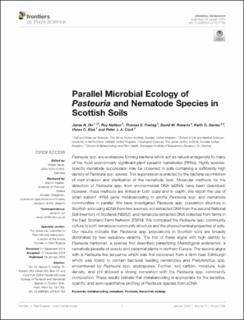| dc.contributor.author | Orr, Jamie N. | |
| dc.contributor.author | Neilson, Roy | |
| dc.contributor.author | Freitag, Thomas E. | |
| dc.contributor.author | Roberts, David M. | |
| dc.contributor.author | Davies, Keith | |
| dc.contributor.author | Blok, Vivian C. | |
| dc.contributor.author | Cock, Peter J. A. | |
| dc.date.accessioned | 2020-11-19T09:36:35Z | |
| dc.date.available | 2020-11-19T09:36:35Z | |
| dc.date.created | 2020-10-22T15:55:56Z | |
| dc.date.issued | 2020-01-28 | |
| dc.identifier.citation | Frontiers in Plant Science. 2020, 10 1-18. | en_US |
| dc.identifier.issn | 1664-462X | |
| dc.identifier.uri | https://hdl.handle.net/11250/2688618 | |
| dc.description.abstract | Pasteuria spp. are endospore forming bacteria which act as natural antagonists to many of the most economically significant plant parasitic nematodes (PPNs). Highly species-specific nematode suppression may be observed in soils containing a sufficiently high density of Pasteuria spp. spores. This suppression is enacted by the bacteria via inhibition of root invasion and sterilization of the nematode host. Molecular methods for the detection of Pasteuria spp. from environmental DNA (eDNA) have been described; however, these methods are limited in both scale and in depth. We report the use of small subunit rRNA gene metabarcoding to profile Pasteuria spp. and nematode communities in parallel. We have investigated Pasteuria spp. population structure in Scottish soils using eDNA from two sources: soil extracted DNA from the second National Soil Inventory of Scotland (NSIS2); and nematode extracted DNA collected from farms in the East Scotland Farm Network (ESFN). We compared the Pasteuria spp. community culture to both nematode community structure and the physiochemical properties of soils. Our results indicate that Pasteuria spp. populations in Scottish soils are broadly dominated by two sequence variants. The first of these aligns with high identity to Pasteuria hartismeri, a species first described parasitizing Meloidogyne ardenensis, a nematode parasite of woody and perennial plants in northern Europe. The second aligns with a Pasteuria-like sequence which was first recovered from a farm near Edinburgh which was found to contain bacterial feeding nematodes and Pratylenchus spp. encumbered by Pasteuria spp. endospores. Further, soil carbon, moisture, bulk density, and pH showed a strong correlation with the Pasteuria spp. community composition. These results indicate that metabarcoding is appropriate for the sensitive, specific, and semi-quantitative profiling of Pasteuria species from eDNA. | en_US |
| dc.language.iso | eng | en_US |
| dc.publisher | Frontiers Media S.A. | en_US |
| dc.rights | Navngivelse 4.0 Internasjonal | * |
| dc.rights.uri | http://creativecommons.org/licenses/by/4.0/deed.no | * |
| dc.title | Parallel Microbial Ecology of Pasteuria and Nematode Species in Scottish Soils | en_US |
| dc.type | Peer reviewed | en_US |
| dc.type | Journal article | en_US |
| dc.description.version | publishedVersion | en_US |
| dc.rights.holder | © 2020 Orr, Neilson, Freitag, Roberts, Davies, Blok and Cock. | en_US |
| dc.source.pagenumber | 1-18 | en_US |
| dc.source.volume | 10 | en_US |
| dc.source.journal | Frontiers in Plant Science | en_US |
| dc.identifier.doi | 10.3389/fpls.2019.01763 | |
| dc.identifier.cristin | 1841599 | |
| dc.source.articlenumber | 1763 | en_US |
| cristin.ispublished | true | |
| cristin.fulltext | original | |
| cristin.qualitycode | 2 | |

